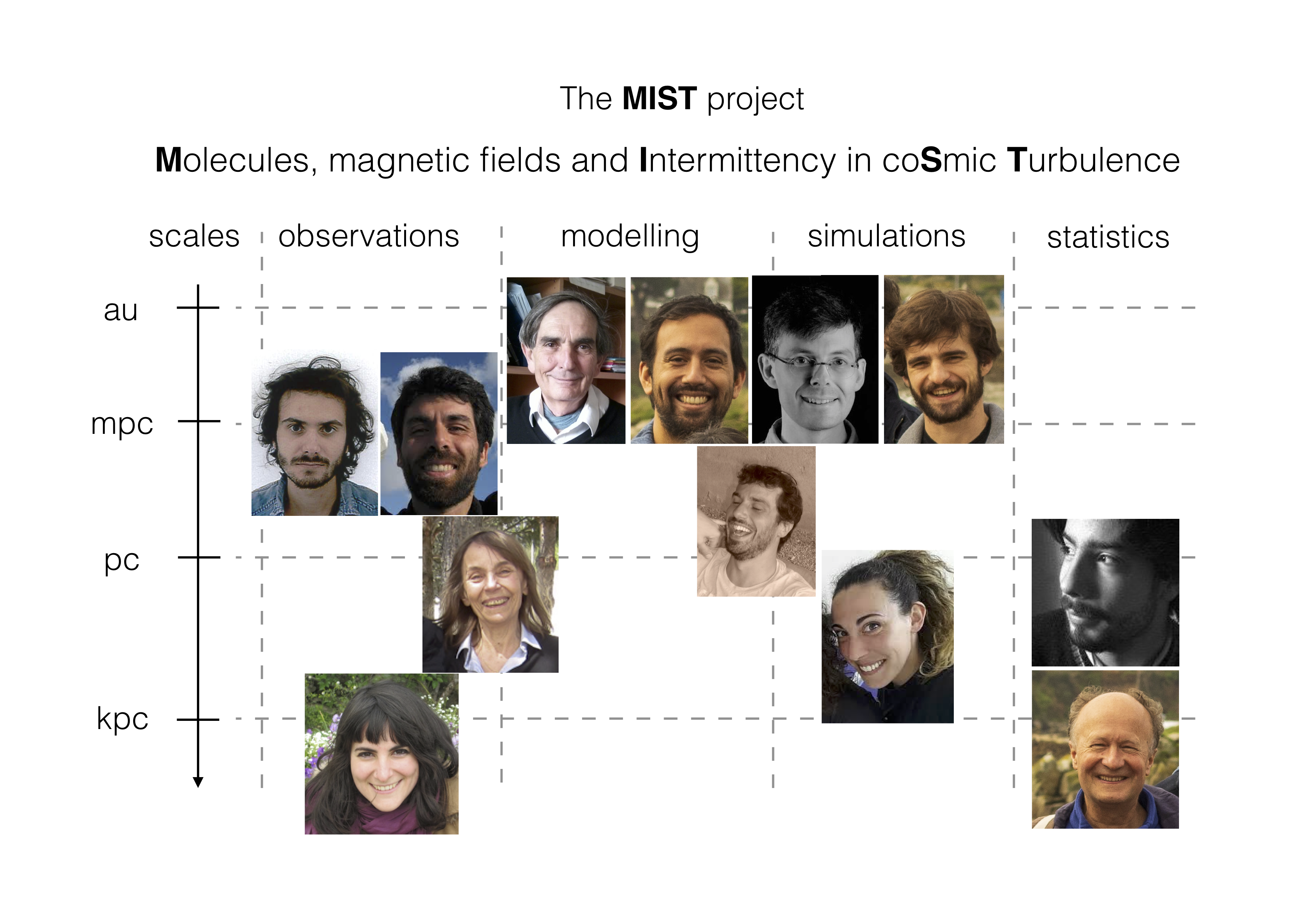The MIST team
The MIST team gathers researchers with very different and remarkably complementary fields of competence.
Edith Falgarone (PI) (Emeritus Director of Research, CNRS) is an expert on the physics of the interstellar medium and star formation, with a particular emphasis on turbulence and magnetic fields. She has a broad experience in millimetre and sub-millimetre molecular line observations. She has a decades-long expertise in leading many original studies to disclose the signatures of intermittency of cosmic turbulence, its impact on the physics of the ISM and on star-formation. She was part of the Herschel/HIFI consortium and joined the Planck collaboration for the analyses of the Galactic foregrounds. She is leading the ALMA and NOEMA collaborations on the molecular line observations of starburst galaxies (CH+, OH+ and H2O+). The MIST project is a final touch on the long-sought link between intermittency of turbulence and emergence of structures in the ISM. She ensures the coordination between the different team members and their research axes. She devotes 80% of her research time to that project.
François Boulanger (Director of Research, CNRS) is an expert in the physics of the interstellar medium. He has an extensive experience in data analysis, in the modelling of dust and gas observations, and in the characterization of the interstellar medium structure. He was the PI of the ERC advanced grant MISTIC focused on the analysis of Planck polarization data, studying the structure of the magnetized interstellar medium, and characterizing dust emission as a foreground to CMB polarization. He contributes to the MIST work on the magnetic field structure, the upcoming JWST H2 observations and the modelling of the formation of turbulent H2 gas within hot plasma.
Benjamin Godard (Assistant-Astronomer, Observatoire de Paris) is specialized in the numerical modelling of the interstellar medium. He completed his PhD in 2010 on the study of out-of-equilibrium chemistry in dissipative structures of turbulence, during which he built the TDR (Turbulent Dissipation Region) model. He has since been developing all the major state-of-the-art models of interstellar chemistry and radiative transfer, including the Meudon PDR (Photo Dominated Regions) code and the Paris-Durham shock code. He leads the theoretical work on irradiated shocks and on the reduction of chemical network for their integration in numerical simulations.
Guillaume Pineau des Forêts (Emeritus Professor, Université de Paris-Sud) is an expert on shock modelling and the complex gas physics taking place in the interstellar media of galaxies. His specific interest for this project lies in understanding how energy is transferred between bulk motions to turbulence, and how its dissipation impacts the phase balance.
Pierre Lesaffre (Assistant Researcher, CNRS) is a numericist and theoretical physicist who aims at understanding the coupling between gas dynamics and thermo-chemistry. His contributions range from stellar interiors (convection theories, stellar evolution and pre-supernova phases), proto-planetary disks (magneto-rotational instability and planet formation), star formation (proto-stellar and pre-stellar core collapse), winds, jets and shocks in the interstellar medium, to the properties of the turbulent diffuse interstellar medium (decaying magneto-hydrodynamical (MHD) turbulence and its dissipation, ambipolar diffusion). He has participated in the development of a number of codes for astrophysical fluid dynamics which are widely used in the community: the Paris-Durham stationary shock code, the RAMSES and ZEUS 3D MHD codes, the STARS and MESA stellar evolution codes.
Pierre Hily-Blant (Assistant-Professor, Université de Grenoble) is studying the evolution of interstellar clouds into stars and planets, with a special emphasis on the evolution of the volatile content. He is an expert in interstellar chemistry and observations of turbulence in molecular clouds. He performs radio-astronomy observations with a high success at all facilities in the field, including forefront instruments (IRAM, ALMA). He is also an expert in time-dependent physico-chemical models and line radiative transfer.
François Levrier (Assistant-Professor, Ecole Normale Supérieure de Paris) focuses his research on the statistical analysis of emission maps from the Galactic interstellar medium. He has recently applied this expertise to Planck maps of polarized thermal dust emission, which not only represent a very valuable tool for understanding the astrophysics of the ISM, but also for the proper interpretation of the cosmological signal. His research interests range from the diffuse ISM to star formation with an emphasis on advanced statistical methods.
Andrew Lehmann (Post-doc, LPENS) joined the team in October 2017 to further develop models of magnetized molecular shocks and increase their domain of relevance. His PhD, conducted in Australia under the supervision of Mark Wardle, focused on the signatures of fast and slow shocks in MHD turbulence. He developed a code, widely used by the community, to recognize shocks in MHD turbulence.
Alba Vidal Garcia (Post-doc, LPENS) joined the team in May 2018 to enter the galaxy evolution facet of the project and lead the JWST observational efforts. She studied in Spain and her PhD under the supervision of Stéphane Charlot in Paris was intended to disentangle the stellar and ISM contributions to the UV-line diagnostics of galactic evolution.
Thibaud Richard (PhD student, LPENS) started his PhD under the supervision of Pierre Lesaffre in October 2018. The main goal of his PhD is to characterize the coherent structures that are responsible for the space-time intermittency of turbulent dissipation in compressible MHD turbulence. His numerical simulations are intended to probe the dominant processes, namely ohmic versus viscous dissipation, under different magnetic and kinetic environments.
Simon Delcamp (PhD student, IPAG) started his PhD under the supervision of Pierre Hily-Blant in October 2019. His PhD is based on IRAM-NOEMA and ALMA-ACA imaging of the smallest structures accessible with molecular tracers in the nearby ISM. The ultimate goal is to unveil the origin of the remarkable filamentary structures observed so far, in the light of the numerical simulations of MHD turbulence and non-equilibrium chemistry models performed by the team.
Elena Bellomi (PhD student, LPENS) will complete her PhD under the supervision of Benjamin Godard in the 2020 fall. She is not supported by the MIST project but her PhD is closely connected to the part of the MIST project “Turbulence in multiphasic media”.
